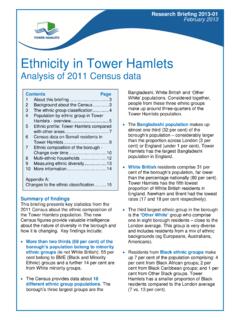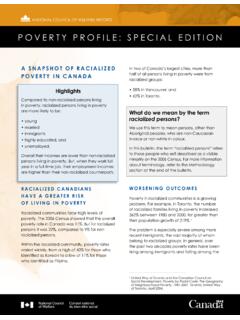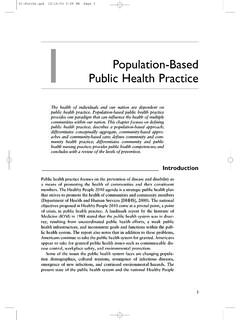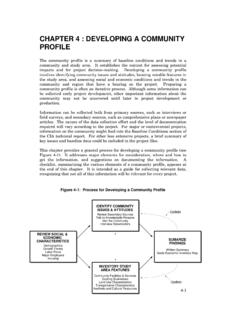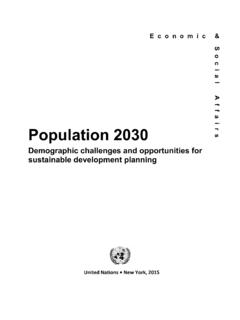Transcription of 2. Population - Tower Hamlets
1 Borough profile 2018 2. Population Tower Hamlets continues to be one of the fastest growing, youngest, and most diverse populations in the UK. Chapter Summary: The borough had 308,000 residents as of June 2017. Since 1986, the Population has more than doubled making Tower Hamlets the fastest growing local authority in the UK. Our Population is projected to reach 365,200 by 2027 equivalent to around 15 additional residents per day for the next ten years. The Population is expected to reach 400,000 by 2041.
2 Over 54,000 new homes are expected to be built in the borough by 2030/31. An estimated 125,900 households lived in the borough in 2016. Tower Hamlets has a relatively complex household composition: one in five households is made up of more than one family and 7 per cent of households have more than six people (compared with 4 per cent in London). Tower Hamlets remains the second most densely Population local authority in the UK, next to Islington. We have the 4th youngest Population in the UK.
3 Almost half of our residents (46 per cent) are aged 20-39. We have around 12,900 more male residents than female residents, putting the Male to Female Ratio at The borough is ranked as the 16th most ethnically diverse local authority in England in terms of the mix of different ethnic group populations. More than two thirds of our residents belong to minority ethnic groups. Tower Hamlets is home to the largest Bangladeshi Population in the country, making up 32 per cent of our Population . More than four in ten residents (43 per cent) were born outside the UK.
4 Residents born in Bangladesh are the single biggest migrant group, but the most significant Population growth in recent years was among EU nationals. 38 per cent of our residents are Muslim the highest proportion in the UK. Borough profile 2018: Population 2 What is the Population of Tower Hamlets ? The Office for National Statistics (ONS) estimated the usual resident Population of Tower Hamlets to be 308,000 as at 30 June In the year to June 2017, the borough gained an estimated 7,000 additional residents.
5 That is equivalent to 20 additional residents every day over the year. In terms of Population size, Tower Hamlets is ranked 11th largest out of the 32 London Boroughs and City (see Figure ). The borough rankings are largely unchanged in the past year. How is our Population growing? The Population of Tower Hamlets has nearly doubled in the past 30 years, rising from 156,000 in 1987 to 308,000 in Growth has been particularly fast over the last decade. Between 2007 and 2017, the Population grew by 82,700 residents a 37 per cent increase.
6 This was the fastest Population increase out of all 391 local authority areas in the UK. The borough s Population growth rate (37 per cent) was also more than double that in London (15 per cent) and more than four times that in England (8 per cent). Our rapid Population growth is expected to continue. For Tower Hamlets , the most important factor for projecting future Population growth is housing development. Between 2017/18 and 2030/31, over 54,000 additional homes are expected to be built in the borough.
7 Map shows that nearly half of these new homes (49 per cent) will be concentrated in the Isle of Dogs (Canary Wharf and Blackwall & Cubitt Town wards). Taking this expected development into account, projections from the Greater London Authority (GLA) expected to reach 365,200 by 20273 (see Figure ). This would be an increase of around 54,000 residents over the next decade equivalent to an average of around 15 additional residents every day for the next ten years. The borough s Population is expected to reach 400,000 by 2041.
8 Borough profile 2018: Population 3 Map : Projected number of new housing units to be built between 2016/17 and 2030/31 by ward Borough profile 2018: Population 4 However, it should be noted that these projections on based on recent trends and do not attempt to take into account the impact of the UK leaving the European Union (known as Brexit ). This will likely have an impact on the UK economy, labour market, and migration patterns, which will consequently affect the Population of Tower Hamlets .
9 The borough s Population growth has largely been driven by international migration. Over the past ten years, it is estimated that net international migration increased our Population by around 62,300 residents because more people from abroad moved to the UK than those who left the UK from Tower On the other hand, more people left Tower Hamlets to move elsewhere in the UK than those moving into the borough from other local authorities, leading to a loss of around 11,400 residents. A significant proportion of the borough s international migration has come from the European Union.
10 In 2011, one in ten of the borough s residents were born in EU countries (other than the UK).5 EU nationals have accounted for seven in ten of the borough s economic migrants over the past five Brexit is likely to reduce migration from EU countries, so our Population growth may well be lower than what is projected. Figure shows that while economic migration - measured through registration for new National Insurance Numbers (NINo) to overseas nationals - is still high for EU nationals, there has been a fall over the past three financial years.

